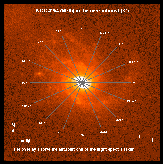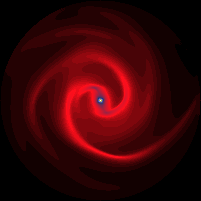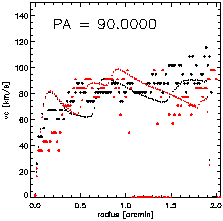Measuring stellar and dark mass fractions in spiral galaxies
T. Kranz,
A. Slyz, H.-W.
Rix
Max-Planck Institut für Astronomie,
Heidelberg, Germany
Introduction
In almost all galaxy formation scenarios non baryonic dark matter plays
an important role. Today's numerical simulations of cosmological structure
evolution quite successfully reproduce the observed galaxy distribution
in the universe (e.g. Kauffmann et al., 1999). While galaxies form and evolve
inside of dark halos their physical appearance depends strongly on the
local starformation an merging history. In the same time the halos evolve
and merge as well. According to the simulations, we expect that the dark
matter is of comparable importance in the inner parts of galaxies (Navarro,
Frenk, White, 1996/97) and it thus has a considerable influence on the kinematics.
These predictions are in contrast to some studies which indicate
that galactic stellar disks - at least of barred spiral galaxies -
alone dominate the kinematics of the inner regions (e.g. Debattista, Sellwood,
2000). Apparently this is also the case in our own Milky Way (Gerhard, 1999).
Determining individual mass fractions of the luminous and dark matter
is not a straightforward task. The rotation curve of a disk galaxy is
only sensitive to the total amount of gravitating matter, but does not
allow to distinguish the two mass density profiles. For a detailed analysis
it is necessary to adopt more refined methods to separate out the different
profiles. Previous investigations used for example knowledge of kinematics
of rotating bars (Weiner, 1999) or the geometry of gravitational lens systems
(Maller et al., 2000).
Here we would like to exploit the fact, that the stellar mass in
disk galaxies is often organized in spiral arms, thus in clearly non-axisymmetric
structures. On the other hand, in most proposed scenarios, the dark matter
is non-collisional and dominated by random motions. It is not susceptible
to spiral structures and distributed like the stars in elliptical galaxies.
If the stellar mass dominates, the arms could induce considerable non-circular
motions in the gas, which should become visible as velocity wiggles in
observed gas kinematics. Using hydrodynamical gas simulations we are able
to predict these velocity wiggles and compare them to the observations.
Hence the contribution of the perturbative forces with respect to the total
forces can be determined quantitatively and can be used to constrain the
disk to halo mass ratio.
| Observations
For this analysis we need data to provide us with information on the
stellar mass distribution and on the gas kinematics of a sample of galaxies.
To map the stellar surface mass density it is most desirable to take near
infrared (NIR) images of the galaxies, because dust extinction and population
effects are minimized (e.g. Rix, Rieke, 1993). During two observing runs in
May '99 and March '00 we obtained photometric data for ~20 closeby NGC
galaxies. We used the Omega
Prime camera at the Calar Alto 3.5m
telescope with the K-band filter (K'). It provides us with a field of view
of 6.76' x 6.76'. Figure 1 shows the K-band image of the Messier galaxy
M99.
The kinematic data was obtained with the
TWIN,
a longslit spectrograph
for the 3.5m telescope. To reach a reasonable coverage of the galaxies'
velocity field, we needed to take 8 slit positions across the entire disk
of the galaxies (also displayed in Figure 1). So far we were able to collect
complete sets of longslit spectra for only 4 galaxies, mostly due to only
moderate weather conditions during the spectroscopy runs. |

Figure 1.
Please click on the image
to read captions. |
| First results
As a pilot project, we analyzed the data of NGC 4254 (M99). Assuming a
constant stellar mass to light ratio, the gravitational potential due to the stellar
mass fraction was calculated by direct integration over the whole mass
distribution taken from the NIR-image. The mass to light ratio for the
maximum disk contribution was scaled by the measured rotation curve. For
the dark matter contribution we assumed an isothermal halo with a core.
To combine the two components we chose a stellar mass fraction and added
the halo with the variable parameters adjusted to give a best fit to the
rotation curve.
We used this potential as an input for the hydrodynamical gas simulations.
Figure 2
presents the results for the resulting gas surface density, as
it settles in the potenital. The morphology of the gas distribution is
very sensitive to the velocity, with which the spiral pattern of the galaxy
rotates (pattern speed). In figure 2
we printed the result of the simulation
with the spiral structure matching best to the K-band image morphology.
We find quite good agreement.
In figure 3
a comparison of the modelled and the measured rotation
curves are presented for one particular position angle. The four panels
show the rotation curves for different disk mass fractions, ranging from
almost none to maximum disk case. |

Figure 2.
Please click on the image
to read captions. |
| Conclusions and discussion
Although there is quite some scatter in the observed data, we find that
the velocity jumps, which are apparent in the simulations for the 85% case
are too large to be in agreement with the measurements. On the other hand
the simulated velocity wiggles in the 20% case seem too small to match
the observations. The inner part of the simulated rotation curve (<
0.5') is dominated by the dynamics of the small bar, which is present at
the center of the galaxy. Its pattern speed might be different from the
one of the spirals and thus relate to a mismatch in the inner part of the
rotation curve.
We conclude that an axisymmetric dark halo is needed to explain the
kinematics of the stellar disk. The influence of the stellar disk is submaximal
in that respect that we don't find strong enough velocity wiggles in the
observed kinematics as it would be expected if the stellar disk was the
major gravitating source inside the inner few disk scale lenghts.
How this conclusion might apply to other spiral galaxies will be the
upcoming issue of this project. We plan to extend our analysis at first
on the 3 other galaxies where we have already now complete data sets. Finally
we intend to draw our final conclusions on a basis of a sample consisting
of 8 - 10 members. This should be sufficient to determine reliable results
about the luminous and dark mass distributions in spiral galaxies. |

Figure 3.
85% disk. To see all panels
and read the captions
please click on the image . |
References
Debattista
V. P., Sellwood J. A., 2000, astro-ph/0006275
Gerhard O.,
1999, astro-ph/9902247
Kauffmann
G., Colberg J., Diaferio A., White S. D. M., 1999, MNRAS, 303, 188
Maller A., et al., 2000, ApJ, 533, 194
Navarro
J., Frenk C., White S. D., 1996, ApJ, 462, 563
Navarro
J., Frenk C., White S. D., 1997, ApJ, 490, 493
Rix
H.-W., Rieke M., 1993, ApJ, 418, 123
Weiner B., 1999, Talk at 'disk99' workshop, MPIA Heidelberg


